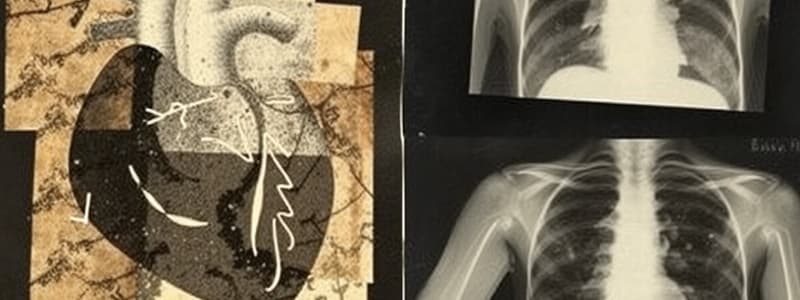Podcast
Questions and Answers
What is the primary method used for measuring the JVP?
What is the primary method used for measuring the JVP?
- Tape measure along the jugular vein
- Vertical ruler with a tilted card
- Horizontal card and vertical ruler (correct)
- Straight ruler aligned with the heart
Which fingers are typically used to palpate the carotid pulse?
Which fingers are typically used to palpate the carotid pulse?
- Thumb and little
- Index and thumb
- Middle and ring
- Index and middle (correct)
In which position is the apical impulse commonly palpated?
In which position is the apical impulse commonly palpated?
- Supine position
- Prone position
- Left lateral decubitus position (correct)
- Sitting upright
What does the location of the PMI refer to?
What does the location of the PMI refer to?
Which technique is used to palpate the apical impulse effectively?
Which technique is used to palpate the apical impulse effectively?
What are the auscultatory areas on the chest wall used for?
What are the auscultatory areas on the chest wall used for?
Which condition is best auscultated when the patient is in the left lateral decubitus position?
Which condition is best auscultated when the patient is in the left lateral decubitus position?
What is the purpose of having the patient lean forward during auscultation?
What is the purpose of having the patient lean forward during auscultation?
Which heart condition's sounds may radiate to the neck?
Which heart condition's sounds may radiate to the neck?
What is typically assessed using a stethoscope in cardiac examinations?
What is typically assessed using a stethoscope in cardiac examinations?
Which chamber of the heart receives deoxygenated blood from the body?
Which chamber of the heart receives deoxygenated blood from the body?
What is the primary role of the aorta in the circulatory system?
What is the primary role of the aorta in the circulatory system?
Which structure is part of the cardiac conduction system?
Which structure is part of the cardiac conduction system?
In which position is the jugular venous pressure (JVP) typically assessed?
In which position is the jugular venous pressure (JVP) typically assessed?
Which vessels are specifically involved in carrying blood to and from the lungs?
Which vessels are specifically involved in carrying blood to and from the lungs?
What is the direction of blood flow during diastole in the heart?
What is the direction of blood flow during diastole in the heart?
Which cardiac chamber pumps blood to the lungs for oxygenation?
Which cardiac chamber pumps blood to the lungs for oxygenation?
Which valve prevents backflow from the aorta into the left ventricle?
Which valve prevents backflow from the aorta into the left ventricle?
What does the acronym JVP stand for in relation to cardiac assessment?
What does the acronym JVP stand for in relation to cardiac assessment?
Which structure is found within the left atrium?
Which structure is found within the left atrium?
Flashcards are hidden until you start studying
Study Notes
Cardiac Structures and Imaging
- Major cardiac structures are visualized through the chest wall.
- Normal chest radiographs reveal the cardiac chambers and great vessels:
- Aorta (AO)
- Left Atrium (LA)
- Left Ventricle (LV)
- Pulmonary Artery (PA)
- Right Atrium (RA)
- Right Ventricle (RV)
- Superior Vena Cava (SVC)
Cardiac Anatomy and Circulation
- Key cardiac chambers:
- Right Atrium (RA)
- Left Atrium (LA)
- Right Ventricle (RV)
- Left Ventricle (LV)
- Understanding blood flow direction is essential during the cardiac cycle.
Cardiac Conduction System
- The cardiac conduction system orchestrates electrical impulses that regulate heartbeats.
Jugular Venous Pressure (JVP)
- JVP height remains constant in different patient positions, sometimes detectable only when recumbent or upright.
- Measurement techniques include using a horizontal card and a vertical ruler.
Pulse Examination Techniques
- Palpating for the carotid pulse involves utilizing index and middle fingers for accuracy.
- The apical impulse is best palpated in the left lateral decubitus position.
- The point of maximal impulse (PMI) is described relative to the midsternal or midclavicular lines.
Auscultation and Heart Sounds
- Identifying auscultatory areas on the chest wall is critical for cardiac examination.
- Understanding radiation of heart sounds and murmurs aids in diagnosing heart conditions.
- Specific positions enhance auscultation for particular conditions:
- Mitral stenosis is best assessed in the left lateral decubitus position.
- Aortic regurgitation is evaluated with the patient leaning forward.
Studying That Suits You
Use AI to generate personalized quizzes and flashcards to suit your learning preferences.




